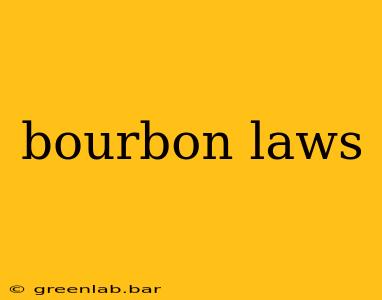Bourbon whiskey, a spirit synonymous with American heritage and craftsmanship, is subject to a surprisingly intricate set of regulations. Understanding these laws is crucial for both producers and consumers alike, ensuring quality, authenticity, and the preservation of this iconic drink's legacy. This comprehensive guide delves into the key aspects of bourbon laws, clarifying the nuances and helping you appreciate the meticulous process behind every bottle.
The Defining Characteristics of Bourbon: Legal Requirements
The defining characteristics of bourbon, as dictated by federal law (primarily Title 27, Chapter 8, Subchapter A of the Code of Federal Regulations), are critical to its identity and legality. These specifications ensure that what you buy is truly bourbon, not just a spirit masquerading as such.
1. Grain Bill: The Heart of the Matter
- At least 51% corn: This is the cornerstone of bourbon's identity. The remaining mash bill can consist of other grains like rye, wheat, and barley, influencing the flavor profile significantly. A high rye content, for instance, creates a spicier bourbon, while a higher wheat content results in a sweeter one.
2. New Charred Oak Barrels: The Essence of Flavor
Bourbon must be aged in new, charred oak barrels. This process is vital for extracting color, flavor, and aroma from the wood, contributing significantly to the spirit's unique character. Re-using barrels is strictly prohibited for bourbon production.
3. Distillation Proof: Limits on Alcohol Content
The maximum distillation proof is 160 (80% alcohol by volume). While this might seem high, it allows for the subsequent aging process to reduce the alcohol content to the levels typically found in bottled bourbon.
4. Bottling Proof: Minimum Strength
There's no minimum bottling proof mandated by federal law, although many bourbons are bottled between 80 and 100 proof (40-50% alcohol by volume).
5. American Production: A Matter of Origin
Bourbon must be produced in the United States. This geographical limitation is integral to its identity and protected status.
Beyond the Basics: Understanding Specific Regulations
While the core characteristics outlined above are fundamental, several other regulations add further layers of complexity to bourbon production:
1. Age Statements: Declaring Maturity
Bourbon may carry an age statement indicating the youngest whiskey in the bottle. For example, a "4-year-old bourbon" means that the youngest whiskey in that bottle has been aged for at least four years. However, the bottle may contain a blend of older whiskeys.
2. Bottling Requirements: Maintaining Integrity
Strict regulations govern the bottling process, ensuring the integrity and accuracy of the product. This includes labeling requirements, which must clearly state the age, proof, and other relevant information.
3. State Laws and Regulations: Added Considerations
Individual states may also have their own regulations concerning bourbon production and sale, often adding further complexities for producers operating within their jurisdictions.
The Importance of Bourbon Laws: Protecting Consumers and Producers
These laws serve a critical purpose: protecting both consumers and producers. They safeguard against mislabeling, ensure quality standards, and prevent the dilution of the bourbon identity. This framework allows consumers to trust the authenticity and quality of the product they purchase, while providing producers with a clear set of guidelines to follow.
Conclusion: A Legacy of Regulation
The intricacies of bourbon laws may appear daunting at first glance, but a deeper understanding reveals a carefully constructed system designed to preserve the heritage and integrity of this American spirit. These laws ensure that the bourbon you enjoy embodies the tradition and quality synonymous with its name. By understanding these regulations, we can better appreciate the dedication and craftsmanship that go into every bottle.

